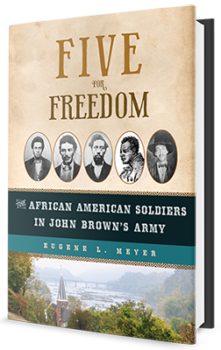Sharing a story from the past relevant to the present
Dear Reader,
Some good news and a challenge:
February was an amazingly busy month for FIVE FOR FREEDOM. I was honored to share the story of “The African American Soldiers in John Brown’s Army” on seven occasions, in venues from Northwest DC to Rockville to Manassas to Oberlin, Ohio, where I spoke from the pulpit of the historic First Church, preceded there by such luminaries as Frederick Douglass, Martin Luther King, Mark Twain, Angela Davis, Tony Morrison and many others.
I’ve been gratified by the continued interest in these “hidden figures” who fought and died for the cause of abolition. To date, I’ve done 28 personal appearances to tell their stories, plus podcasts and radio interviews. Currently, I still have four more events scheduled into October, locally, and as far away as Detroit. Meanwhile, a Canadian film company is producing a six-part documentary about slavery. One episode on abolition will be filmed at Harpers Ferry, where a descendant of John Anthony Copeland, one of the five, executed Dec. 16, 1859, and I will be narrating the dramatic story as we walk in the town. Stay tuned for more details as they become available.
This is truly an American story, and its relevance is evident every day as race and color continue to define and divide us in insidious, often horrific ways that remind us that America’s original sin of slavery has yet to be purged from the land. The message I bring, along with the story itself, has also been expressed by former New Orleans mayor Mitch Landrieu, a white Southerner, who told the New York Times:
“It is essential, if we really want to move forward, that we do so together. We cannot do that unless we deal forthrightly with the issue of race. And unless and until we do that, we’re never going to reach that aspirational moment where out of many we are one.”
My challenge:
..and also my request is for you to share FIVE FOR FREEDOM and its enduring legacy with as many people as possible. If you’ve read the book, please give it an honest review on Amazon and, if you are on Goodreads, please do the same there. If you haven’t yet read it, it’s available on Amazon as an e-book for $9.99 and in hardcover for $16.30 (discounted from $26.99). (I’m happy to sign or inscribe your copy in person or otherwise, logistics to be worked out later.) There is also an audiobook, if you’ve got nine hours and four minutes of listening time to spare! Anyone belong to a book club? There’s a lot in FIVE FOR FREEDOM to digest and discuss, and I love to talk about it. You may contact me through this website.
Race Matters
FYI, on this website, in ARTICLES, I’ve collected several stories under the category of “Race Matters.”
The most recent is a personal reflection on my Long Island, New York boyhood and an incident there in the 1950s that forever shaped my world view. It ran in Long Island Newsday. To read it, click here.
For Columbia Journalism Review online, I shared a mini-memoir on my role as a union activist at the Washington Post during the 1970s. It’s called “Solidarity (almost) forever).” Click here.
Finally, for anyone concerned about attacks on the media as “the enemy of the people,” I offer my review of former NY Times Executive Editor Jill Abramson’s Merchants of Truth: The Business of News and the Fight for Facts. My piece appeared in the Washington Independent Review of Books. Click here.

Your book is a terrific read. I learned so much, including about Oberlin, a community I know. Such important history–kudos to you for unearthing all of its dimensions and personalities.
Dear Gene,
So glad to hear of your success with Five for Freedom.
I am unable to travel to Harpers Ferry in October and wish you a meaningful contribution for the 160th anniversary of the raid.
We may be having an event at the California Historical Society about Brown’s family who emigrated to California in the 1860s and 1870s.